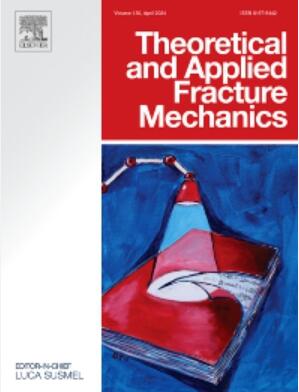Mesoscale modeling of creep damage behavior of UHPFRC under long-term loading
IF 5
2区 工程技术
Q1 ENGINEERING, MECHANICAL
引用次数: 0
Abstract
Ultra high performance fiber reinforced concrete (UHPFRC) demonstrates complex creep and failure mechanisms under long-term loading, posing a challenge to the safety of engineering structures. In this work, a novel computational framework is developed to model the creep damage behavior of UHPFRC. The model considers UHPFRC at the mesoscale, consisting of fibers, mortar, and fiber–matrix interface. The time-dependent constitutive model is used to capture the damage and creep characteristics of concrete mortar. Random distributed fibers are modeled by generating conforming meshes between the fibers and the surrounding mortar. The interfacial bonding and debonding behaviors are described through nonlinear cohesive elements. The proposed model is validated through several numerical simulations of uniaxial creep tests and flexural creep tests. The results show that the developed model can well characterize the time-dependent response of the specimens, which offers promise for the analysis of long-term cracking within UHPFRC structures.
UHPFRC长期加载下蠕变损伤行为的细观模型研究
超高性能纤维混凝土(UHPFRC)在长期荷载作用下表现出复杂的蠕变破坏机制,对工程结构的安全性提出了挑战。在这项工作中,开发了一个新的计算框架来模拟UHPFRC的蠕变损伤行为。该模型在中尺度上考虑了UHPFRC,包括纤维、砂浆和纤维-基质界面。采用时变本构模型来描述混凝土砂浆的损伤和徐变特性。通过生成纤维与周围砂浆之间的一致性网格,对随机分布的纤维进行建模。用非线性内聚元素描述了界面的成键和脱键行为。通过单轴蠕变试验和弯曲蠕变试验的数值模拟验证了该模型的有效性。结果表明,所建立的模型能较好地表征试件的时效响应,为UHPFRC结构的长期开裂分析提供了新的思路。
本文章由计算机程序翻译,如有差异,请以英文原文为准。
求助全文
约1分钟内获得全文
求助全文
来源期刊

Theoretical and Applied Fracture Mechanics
工程技术-工程:机械
CiteScore
8.40
自引率
18.90%
发文量
435
审稿时长
37 days
期刊介绍:
Theoretical and Applied Fracture Mechanics'' aims & scopes have been re-designed to cover both the theoretical, applied, and numerical aspects associated with those cracking related phenomena taking place, at a micro-, meso-, and macroscopic level, in materials/components/structures of any kind.
The journal aims to cover the cracking/mechanical behaviour of materials/components/structures in those situations involving both time-independent and time-dependent system of external forces/moments (such as, for instance, quasi-static, impulsive, impact, blasting, creep, contact, and fatigue loading). Since, under the above circumstances, the mechanical behaviour of cracked materials/components/structures is also affected by the environmental conditions, the journal would consider also those theoretical/experimental research works investigating the effect of external variables such as, for instance, the effect of corrosive environments as well as of high/low-temperature.
 求助内容:
求助内容: 应助结果提醒方式:
应助结果提醒方式:


